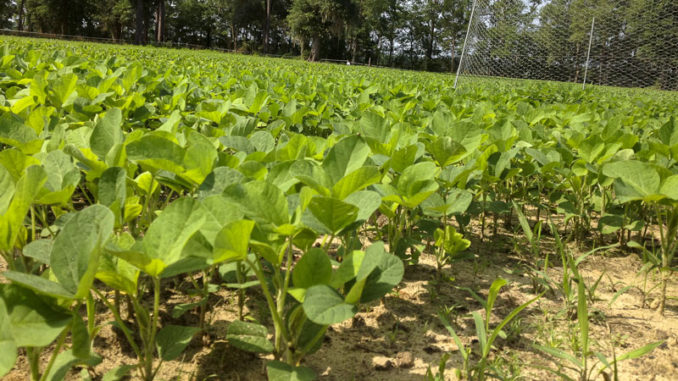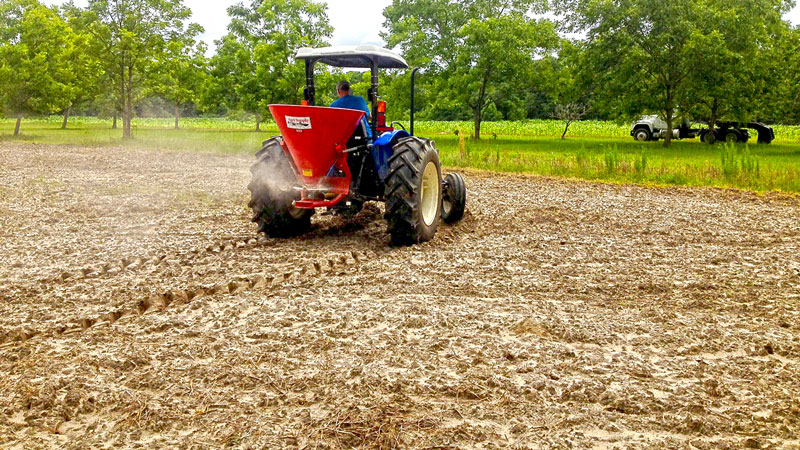
Mother Nature provides essentials, but food plots help
Wildlife need a combination of food, water and cover to fulfill their life needs and to thrive in the natural world. In an ideal setting, Mother Nature provides the essential components to provide adequate food, cover, and water. So what are food plots for?
In the Carolinas, food, cover, and water are generally abundant. Game species have plenty of options to fulfill their needs. So why should hunters invest hundreds and sometimes thousands of hard-earned dollars on food plots and habitat-management activities? That is a great question. And it comes with a great answer.
Food plots serve several purposes for landowners that benefit the landowners/hunters and the wildlife themselves. Wildlife in the temperate Carolinas don’t exactly need food plots for survival. But food plots and habitat-management tactics promote usage on specific properties. And they may provide that extra nutrient boost to fulfill some biological needs.
What is enough?
Most food-plot growers provide as many acres as it is financially and physically feasible to grow and maintain. On smaller properties — 200 acres or less — the area in cultivated plots may be as many as two to three acres, generally spread out over several sites. Larger property owners/managers will grow as many as 50 acres. They spread them out over 20 sites on a 5,000-acre landholding. On most properties, the percentage of food plots is less than 2% of the total land base. And it typically falls closer to 1%.
On a landscape scale, two to three acres of additional protein and mineral-rich crops won’t biggie-size the bucks from 100 inches to Boone & Crockett Club status. And the additional plot acreage will not replace the typical diet of deer and other wildlife species on the farm. Deer will not totally abandon their daily food resources for the new plot of clover that Farmer Fred planted next to his pond.
Desirable food plots will keep wildlife on your property
The Carolinas are flush with above-average conditions in all 150 counties. A mild climate, deep, fertile soils and prevalent rainfall enable vigorous growth of all strata, from the herbaceous level to the canopy level. Mother Nature provides deer, turkey and other native wildlife adequate food resources to flourish throughout the year.
But food plots and habitat-management activities are important to hunters and land managers. Especially for those with an interest in sustaining healthy wildlife populations on their properties. Every county and every property are not created equal. The variability in habitat is immense. In some parts of the two states, commercial agriculture thrives. And in others, large tracts of forestland dominate the landscape, leaving little available land for farmers. Property owners and land managers must work with their own landholdings to make them appealing to wildlife, and to ensure that wildlife stay at home and don’t migrate away to adjoining properties. Wildlife don’t survive on food plots alone. But they will sure stay around to take advantage of the groceries in specific areas.
Taking advantage
Even in an agriculture setting where deer have a 50-acre soybean field available, they will still take advantage of a rich, 1-acre clover plot, deep in the woods. They feel safe away from the dangers associated with the bigger, open field. Food plots don’t replace natural foods or soybeans. They provide supplemental nutrients. And the food source attracts and keeps wildlife on a specific area of land.
Additionally, deer and other wildlife will migrate across property boundaries to take advantage of better habitat conditions, less pressure and tastier groceries. If landowners keep these resources and preferred conditions available, the better the likelihood that deer and other wildlife species will remain happy and grounded at home. If hunters and land managers don’t take care of their deer, neighboring property owners will.
Property managers who promote wildlife with food plots will create as many acres as feasible to provide food across the farm. Food plots will always provide benefits for wildlife with added energy and specific nutrient supplementation. That’s especially beneficial during critical times of the year.

Control expectations on new plots
It can be exciting to plan, grow and watch food plots when wildlife begin to utilize them. But critical chemical reactions need to take place in order to see the planted seeds reach maturity. Every landowner and hunter anticipates the opportunity to reap the benefits of any food-plot project. Yet the first year it may not come out as planned, and expectations should be controlled.
Typically, most new food plots are created out of recently cut forestland or along existing roadways. In these new clearings, the soils are highly disturbed from the land-clearing and grubbing process. The rich and fertile topsoil is mixed with inert underlying soil layers, making a hodgepodge of soil.
Additionally, newly prepared soils are seeded with an abundance of relic, woody debris, resulting from the clearing process. As the woody debris decays, additional acids are introduced into the soil. This contributes to an acidic condition. Most forest soils in the South are inherently acidic. And the decaying matter intermixed with the topsoil produces acidic qualities further enhancing the low pH. A low pH is the first major obstacle to overcome for any new food plot.
New food plots have inherent problems
Heavy doses of lime will need to be added to the soil as soon as it is prepared and ready for production. Limestone can be added in a granular or pelletized form and should be added in multiple applications over the next several years. The first application should be added immediately after clearing to allow the chemical processes to begin to offset the acidic conditions. A soil test can be beneficial on these sites. But one can expect an acidic condition. And an initial lime application will nearly always be required.
Newly-created food plots can be enrolled in the annual spring planting regime. But fertilizer will need to be used sparingly until the soil pH is more balanced. In order for fertilizer to function and be made available to plants, the soil pH must be in an accepted range.
Consider putting off planting until the fall on new food plots
Fertilizers are chemical compounds. And as soon as they are added to the soil, chemical reactions take place and the potassium, nitrogen, and phosphorus bind with other elements present in the soil. The pH will determine which other elements the fertilizer binds with and which products will be produced that will either be available to plants or insoluble and not available for plant uptake. Fertilizer shouldn’t be totally avoided on first plots. But a major usage of the fertilizer will not be experienced in new plots that are typically highly acid.
Since the fertilizers will not have a major effect on plantings, these new plots should be planted with low-maintenance crops or crops with a high tolerance for acidic conditions. Small Burnett is very tolerant of low pH soils. Buckwheat is also another spring planting that can flourish in acidic soils as well.
The best bet for newly created plots is to address the soil conditions head-on and lay off the spring planting season. Instead, treat the soils now and be a little better prepared for the fall planting season. Collect soil samples now and get them tested. But before the results arrive, go ahead and apply a heavy treatment of lime to get the soil-conversion process started immediately.


Be the first to comment